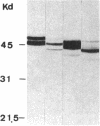Abstract
Previous reports indicate that human hepatocytes do not express class I and class II MHC antigens. Our analyses on 10 human hepatocellular carcinoma (HCC) cell lines by immunofluorescence tests and RIA, demonstrate that all the human HCC cell lines tested express class I MHC antigens and among them, three poorly differentiated human HCC cell lines also express class II MHC antigens. Results of immunoprecipitation and/or Western blotting experiments indicate similarity in the chemical nature of both the class I and class II MHC antigens expressed by the human HCC cell lines and by a human B lymphoblastoid cell line Raji. Furthermore, a new variant form of class I antigen was detected in some of these HCC cell lines. Immunohistochemical studies of HCC tissues using the peroxidase-antiperoxidase staining method indicated that class I and class II antigens were detectable in 7 out of 11 and 3 out of 11 HCC tissues from patients, respectively. The availability of MHC class I antigen-positive cultured HCC cell lines, including the poorly differentiated lines that also express MHC class II antigen, has provided us with interesting models to study the relationship between expression of MHC antigen and transformation and differentiation of human hepatocytes. These studies will also allow us some insight into the role of MHC class I and class II antigen in the immunosensitivity and immunogenicity of HCC cells to the host-immune response.
Full text
PDF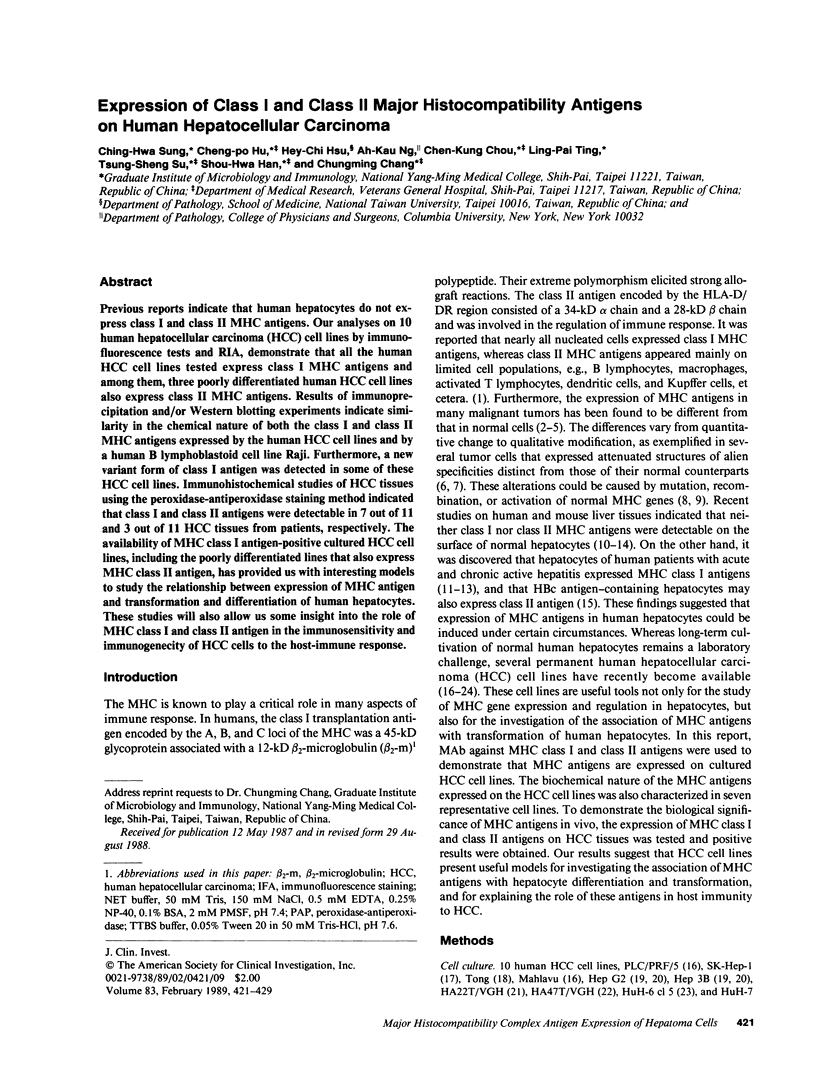
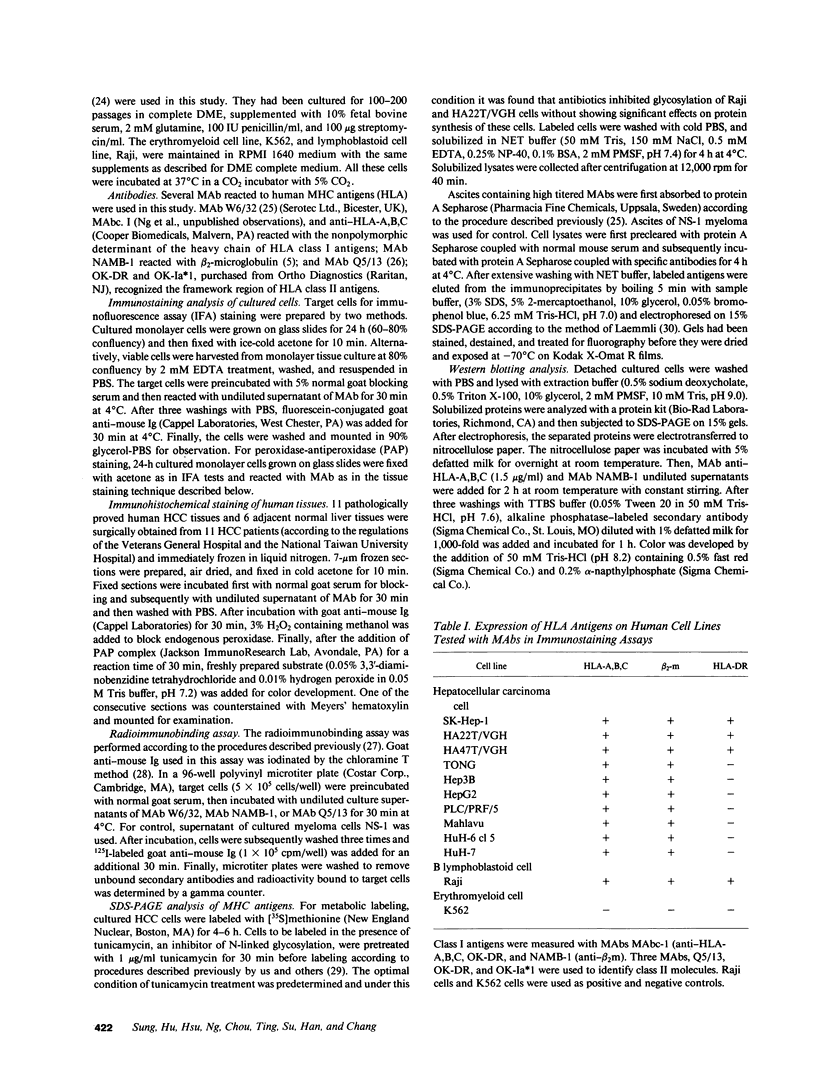
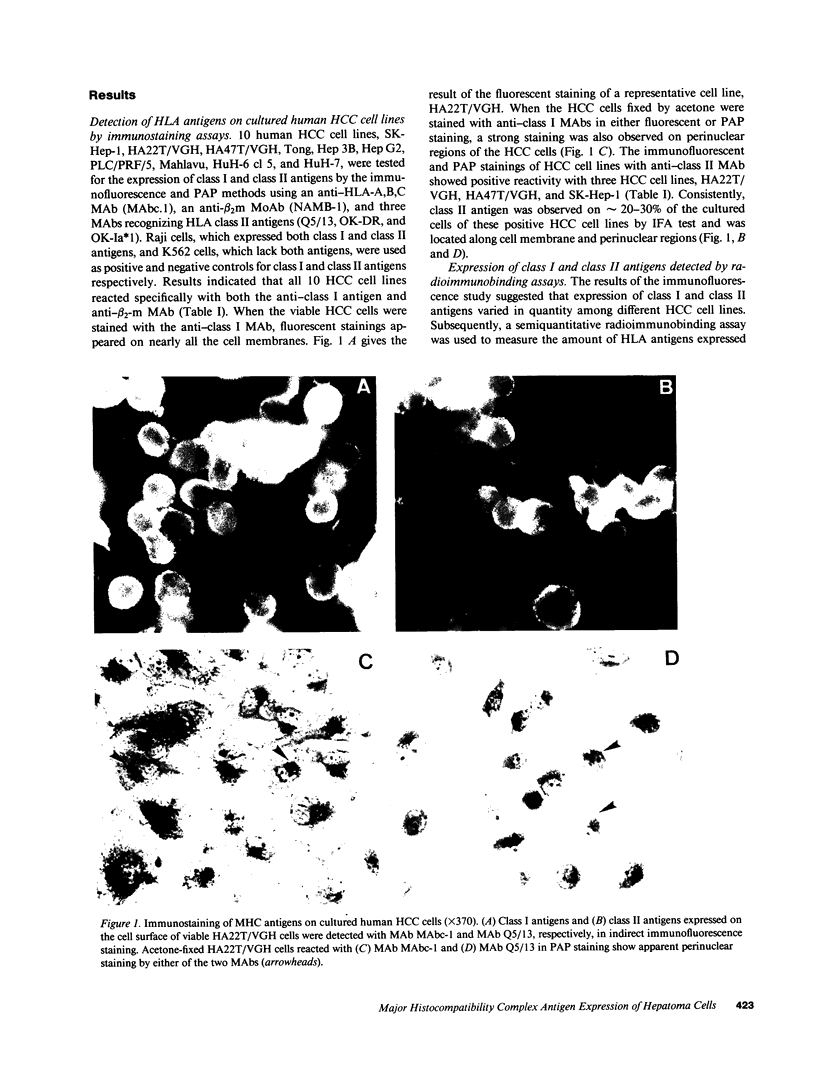
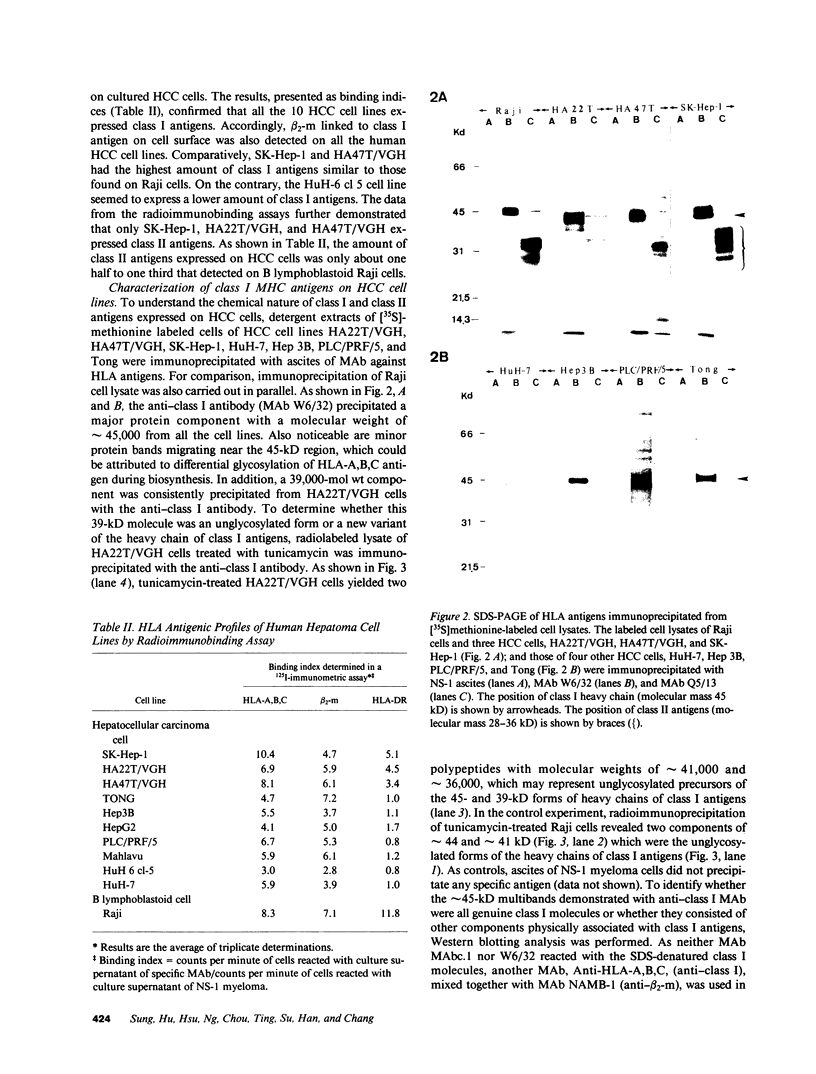
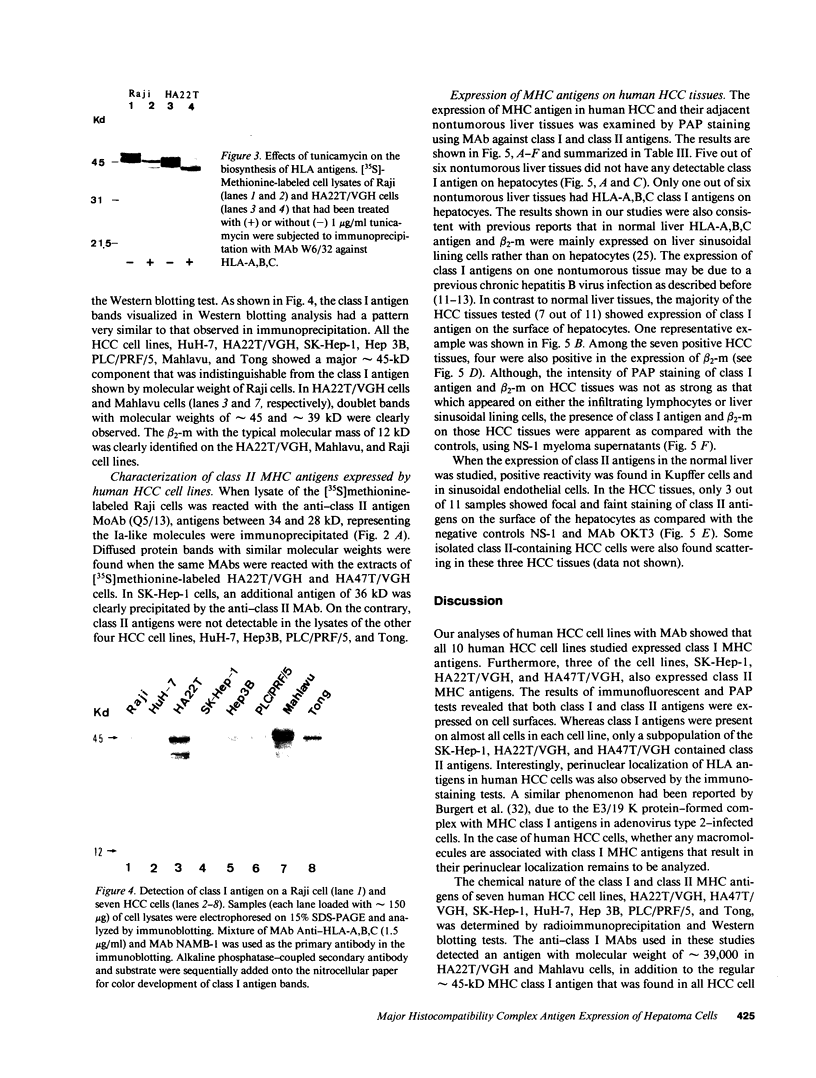
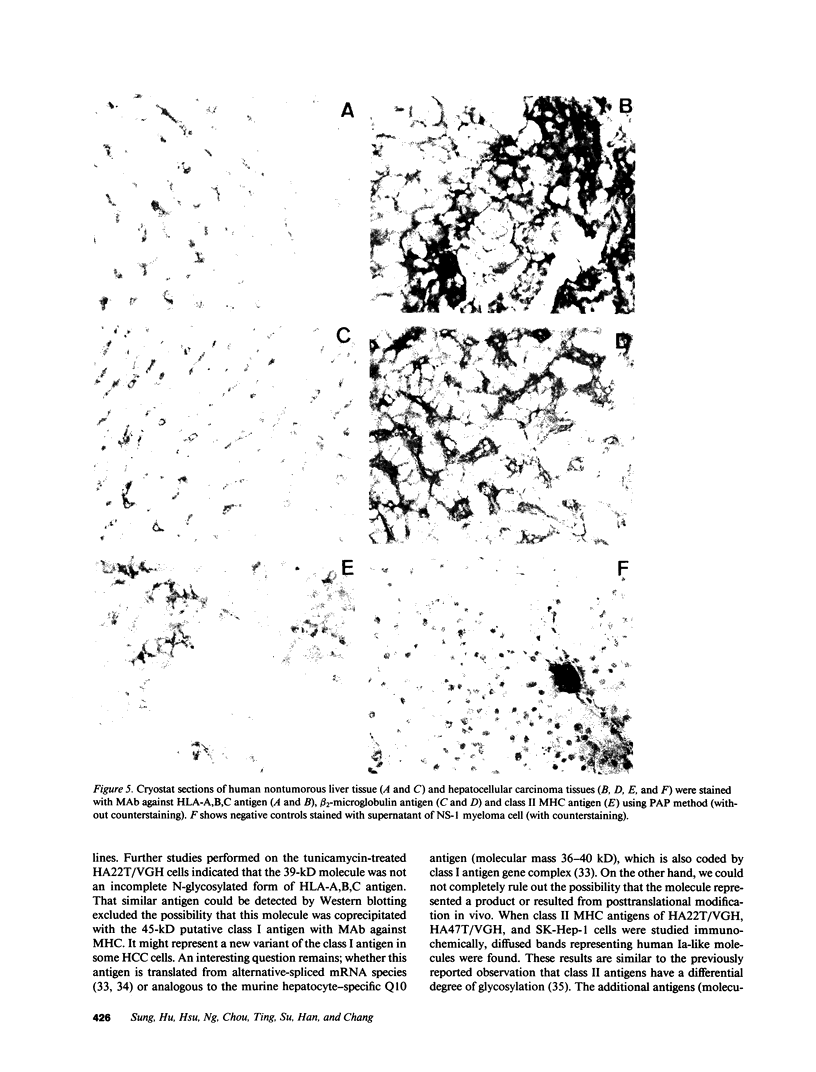
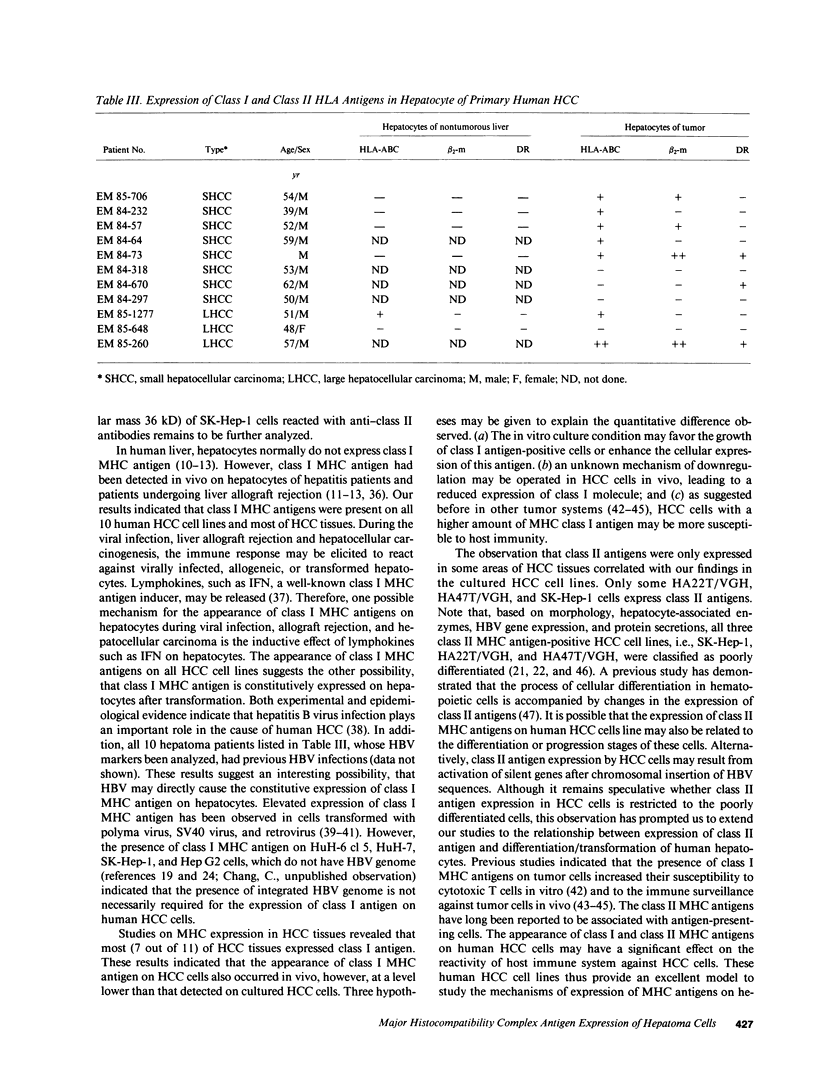
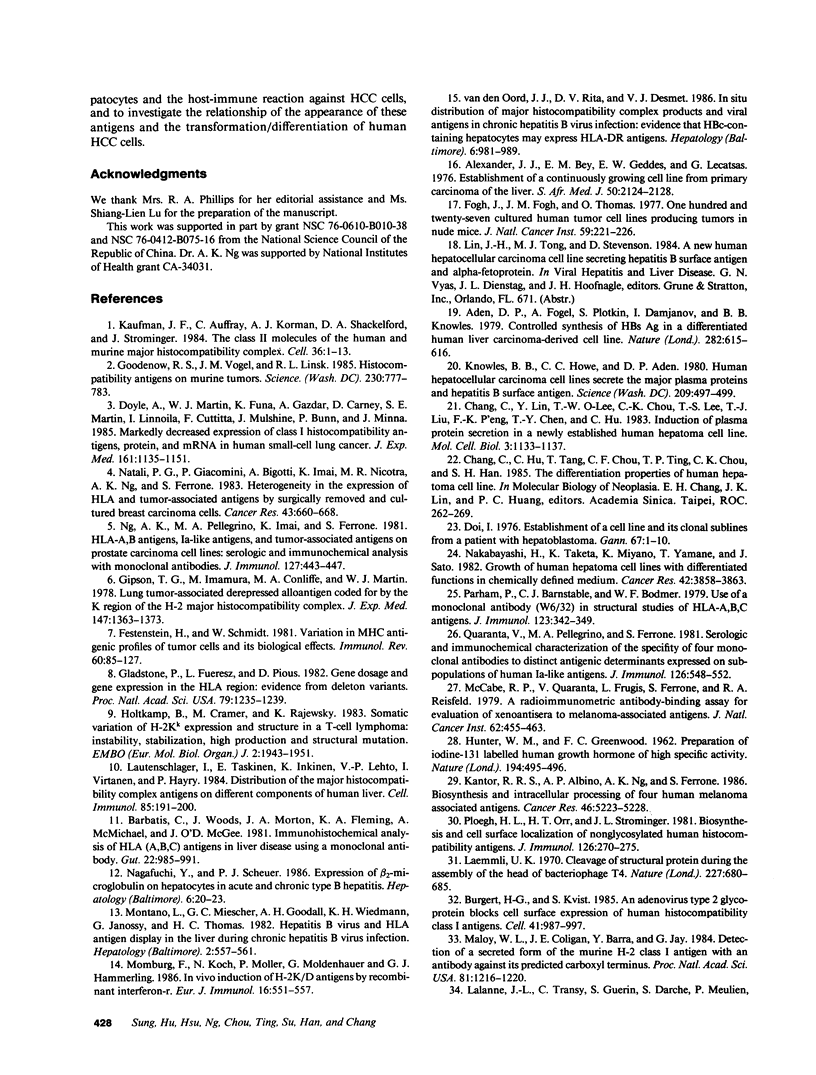
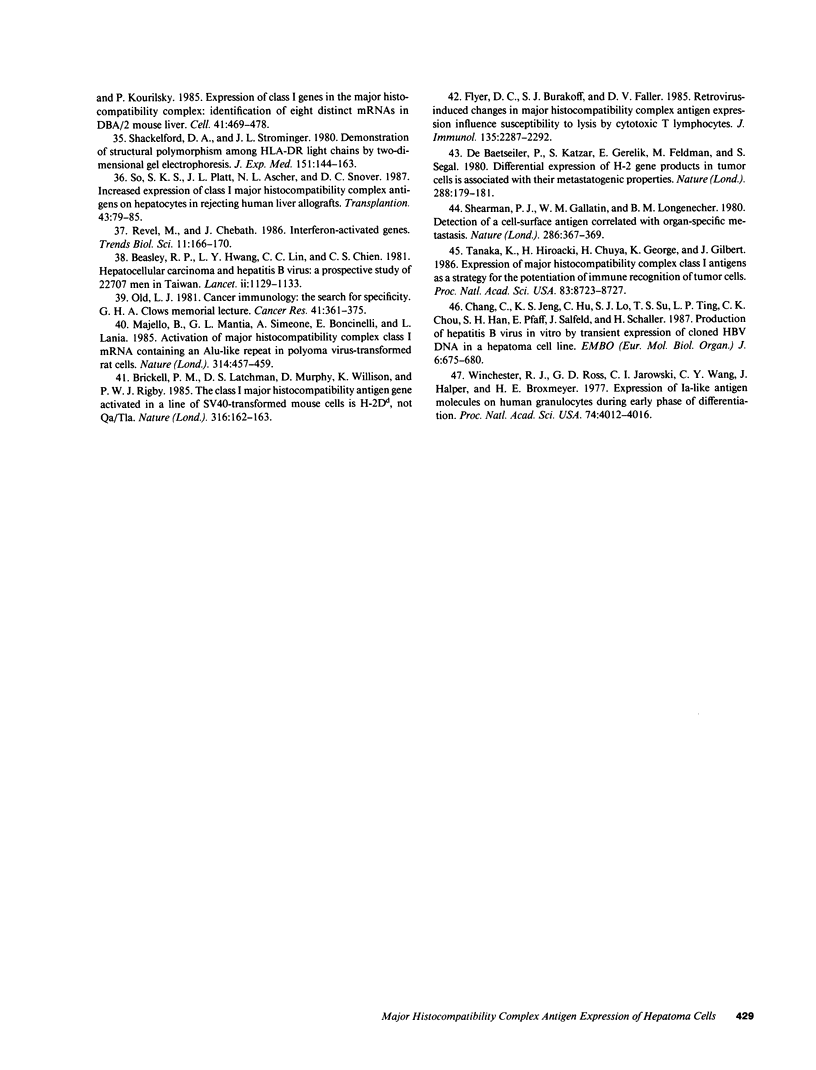
Images in this article
Selected References
These references are in PubMed. This may not be the complete list of references from this article.
- Aden D. P., Fogel A., Plotkin S., Damjanov I., Knowles B. B. Controlled synthesis of HBsAg in a differentiated human liver carcinoma-derived cell line. Nature. 1979 Dec 6;282(5739):615–616. doi: 10.1038/282615a0. [DOI] [PubMed] [Google Scholar]
- Alexander J. J., Bey E. M., Geddes E. W., Lecatsas G. Establishment of a continuously growing cell line from primary carcinoma of the liver. S Afr Med J. 1976 Dec 18;50(54):2124–2128. [PubMed] [Google Scholar]
- Barbatis C., Woods J., Morton J. A., Fleming K. A., McMichael A., McGee J. O. Immunohistochemical analysis of HLA (A, B, C) antigens in liver disease using a monoclonal antibody. Gut. 1981 Dec;22(12):985–991. doi: 10.1136/gut.22.12.985. [DOI] [PMC free article] [PubMed] [Google Scholar]
- Beasley R. P., Hwang L. Y., Lin C. C., Chien C. S. Hepatocellular carcinoma and hepatitis B virus. A prospective study of 22 707 men in Taiwan. Lancet. 1981 Nov 21;2(8256):1129–1133. doi: 10.1016/s0140-6736(81)90585-7. [DOI] [PubMed] [Google Scholar]
- Brickell P. M., Latchman D. S., Murphy D., Willison K., Rigby P. W. The class I major histocompatibility antigen gene activated in a line of SV40-transformed mouse cells is H-2Dd, not Qa/Tla. Nature. 1985 Jul 11;316(6024):162–163. doi: 10.1038/316162a0. [DOI] [PubMed] [Google Scholar]
- Burgert H. G., Kvist S. An adenovirus type 2 glycoprotein blocks cell surface expression of human histocompatibility class I antigens. Cell. 1985 Jul;41(3):987–997. doi: 10.1016/s0092-8674(85)80079-9. [DOI] [PubMed] [Google Scholar]
- Chang C. M., Jeng K. S., Hu C. P., Lo S. J., Su T. S., Ting L. P., Chou C. K., Han S. H., Pfaff E., Salfeld J. Production of hepatitis B virus in vitro by transient expression of cloned HBV DNA in a hepatoma cell line. EMBO J. 1987 Mar;6(3):675–680. doi: 10.1002/j.1460-2075.1987.tb04807.x. [DOI] [PMC free article] [PubMed] [Google Scholar]
- Chang C., Lin Y., O-Lee T. W., Chou C. K., Lee T. S., Liu T. J., P'eng F. K., Chen T. Y., Hu C. P. Induction of plasma protein secretion in a newly established human hepatoma cell line. Mol Cell Biol. 1983 Jun;3(6):1133–1137. doi: 10.1128/mcb.3.6.1133. [DOI] [PMC free article] [PubMed] [Google Scholar]
- De Baetselier P., Katzav S., Gorelik E., Feldman M., Segal S. Differential expression of H-2 gene products in tumour cells in associated with their metastatogenic properties. Nature. 1980 Nov 13;288(5787):179–181. doi: 10.1038/288179a0. [DOI] [PubMed] [Google Scholar]
- Doi I. Establishment of a cell line and its clonal sublines from a patient with hepatoblastoma. Gan. 1976 Feb;67(1):1–10. [PubMed] [Google Scholar]
- Doyle A., Martin W. J., Funa K., Gazdar A., Carney D., Martin S. E., Linnoila I., Cuttitta F., Mulshine J., Bunn P. Markedly decreased expression of class I histocompatibility antigens, protein, and mRNA in human small-cell lung cancer. J Exp Med. 1985 May 1;161(5):1135–1151. doi: 10.1084/jem.161.5.1135. [DOI] [PMC free article] [PubMed] [Google Scholar]
- Festenstein H., Schmidt W. Variation in MHC antigenic profiles of tumor cells and its biological effects. Immunol Rev. 1981;60:85–127. doi: 10.1111/j.1600-065x.1981.tb00363.x. [DOI] [PubMed] [Google Scholar]
- Flyer D. C., Burakoff S. J., Faller D. V. Retrovirus-induced changes in major histocompatibility complex antigen expression influence susceptibility to lysis by cytotoxic T lymphocytes. J Immunol. 1985 Oct;135(4):2287–2292. [PubMed] [Google Scholar]
- Fogh J., Fogh J. M., Orfeo T. One hundred and twenty-seven cultured human tumor cell lines producing tumors in nude mice. J Natl Cancer Inst. 1977 Jul;59(1):221–226. doi: 10.1093/jnci/59.1.221. [DOI] [PubMed] [Google Scholar]
- Gipson T. G., Imamura M., Conliffe M. A., Martin W. J. Lung tumor-associated derepressed alloantigen coded for by the K region of the H-2 major histocompatibility complex. J Exp Med. 1978 May 1;147(5):1363–1373. doi: 10.1084/jem.147.5.1363. [DOI] [PMC free article] [PubMed] [Google Scholar]
- Gladstone P., Fueresz L., Pious D. Gene dosage and gene expression in the HLA region: evidence from deletion variants. Proc Natl Acad Sci U S A. 1982 Feb;79(4):1235–1239. doi: 10.1073/pnas.79.4.1235. [DOI] [PMC free article] [PubMed] [Google Scholar]
- Goodenow R. S., Vogel J. M., Linsk R. L. Histocompatibility antigens on murine tumors. Science. 1985 Nov 15;230(4727):777–783. doi: 10.1126/science.2997918. [DOI] [PubMed] [Google Scholar]
- HUNTER W. M., GREENWOOD F. C. Preparation of iodine-131 labelled human growth hormone of high specific activity. Nature. 1962 May 5;194:495–496. doi: 10.1038/194495a0. [DOI] [PubMed] [Google Scholar]
- Holtkamp B., Cramer M., Rajewsky K. Somatic variation of H-2Kk expression and structure in a T-cell lymphoma: instability, stabilization, high production and structural mutation. EMBO J. 1983;2(11):1943–1951. doi: 10.1002/j.1460-2075.1983.tb01683.x. [DOI] [PMC free article] [PubMed] [Google Scholar]
- Kantor R. R., Albino A. P., Ng A. K., Ferrone S. Biosynthesis and intracellular processing of four human melanoma associated antigens. Cancer Res. 1986 Oct;46(10):5223–5228. [PubMed] [Google Scholar]
- Kaufman J. F., Auffray C., Korman A. J., Shackelford D. A., Strominger J. The class II molecules of the human and murine major histocompatibility complex. Cell. 1984 Jan;36(1):1–13. doi: 10.1016/0092-8674(84)90068-0. [DOI] [PubMed] [Google Scholar]
- Knowles B. B., Howe C. C., Aden D. P. Human hepatocellular carcinoma cell lines secrete the major plasma proteins and hepatitis B surface antigen. Science. 1980 Jul 25;209(4455):497–499. doi: 10.1126/science.6248960. [DOI] [PubMed] [Google Scholar]
- Laemmli U. K. Cleavage of structural proteins during the assembly of the head of bacteriophage T4. Nature. 1970 Aug 15;227(5259):680–685. doi: 10.1038/227680a0. [DOI] [PubMed] [Google Scholar]
- Lalanne J. L., Transy C., Guerin S., Darche S., Meulien P., Kourilsky P. Expression of class I genes in the major histocompatibility complex: identification of eight distinct mRNAs in DBA/2 mouse liver. Cell. 1985 Jun;41(2):469–478. doi: 10.1016/s0092-8674(85)80020-9. [DOI] [PubMed] [Google Scholar]
- Lautenschlager I., Taskinen E., Inkinen K., Lehto V. P., Virtanen I., Häyry P. Distribution of the major histocompatibility complex antigens on different cellular components of human liver. Cell Immunol. 1984 Apr 15;85(1):191–200. doi: 10.1016/0008-8749(84)90289-2. [DOI] [PubMed] [Google Scholar]
- Majello B., La Mantia G., Simeone A., Boncinelli E., Lania L. Activation of major histocompatibility complex class I mRNA containing an Alu-like repeat in polyoma virus-transformed rat cells. Nature. 1985 Apr 4;314(6010):457–459. doi: 10.1038/314457a0. [DOI] [PubMed] [Google Scholar]
- Maloy W. L., Coligan J. E., Barra Y., Jay G. Detection of a secreted form of the murine H-2 class I antigen with an antibody against its predicted carboxyl terminus. Proc Natl Acad Sci U S A. 1984 Feb;81(4):1216–1220. doi: 10.1073/pnas.81.4.1216. [DOI] [PMC free article] [PubMed] [Google Scholar]
- McCabe R. P., Quaranta V., Frugis L., Ferrone S., Reisfeld R. A. A radioimmunometric antibody-binding assay for evaluation of xenoantisera to melanoma-associated antigens. J Natl Cancer Inst. 1979 Mar;62(3):455–463. doi: 10.1093/jnci/62.3.455. [DOI] [PubMed] [Google Scholar]
- Momburg F., Koch N., Möller P., Moldenhauer G., Hämmerling G. J. In vivo induction of H-2K/D antigens by recombinant interferon-gamma. Eur J Immunol. 1986 May;16(5):551–557. doi: 10.1002/eji.1830160516. [DOI] [PubMed] [Google Scholar]
- Montano L., Miescher G. C., Goodall A. H., Wiedmann K. H., Janossy G., Thomas H. C. Hepatitis B virus and HLA antigen display in the liver during chronic hepatitis B virus infection. Hepatology. 1982 Sep-Oct;2(5):557–561. doi: 10.1002/hep.1840020508. [DOI] [PubMed] [Google Scholar]
- Nagafuchi Y., Scheuer P. J. Expression of beta 2-microglobulin on hepatocytes in acute and chronic type B hepatitis. Hepatology. 1986 Jan-Feb;6(1):20–23. doi: 10.1002/hep.1840060105. [DOI] [PubMed] [Google Scholar]
- Nakabayashi H., Taketa K., Miyano K., Yamane T., Sato J. Growth of human hepatoma cells lines with differentiated functions in chemically defined medium. Cancer Res. 1982 Sep;42(9):3858–3863. [PubMed] [Google Scholar]
- Natali P. G., Giacomini P., Bigotti A., Imai K., Nicotra M. R., Ng A. K., Ferrone S. Heterogeneity in the expression of HLA and tumor-associated antigens by surgically removed and cultured breast carcinoma cells. Cancer Res. 1983 Feb;43(2):660–668. [PubMed] [Google Scholar]
- Ng A. K., Pellegrino M. A., Imai K., Ferrone S. HLA-A,B antigens Ia-like antigens, and tumor-associated antigens on prostate carcinoma cell lines: serologic and immunochemical analysis with monoclonal antibodies. J Immunol. 1981 Aug;127(2):443–447. [PubMed] [Google Scholar]
- Old L. J. Cancer immunology: the search for specificity--G. H. A. Clowes Memorial lecture. Cancer Res. 1981 Feb;41(2):361–375. [PubMed] [Google Scholar]
- Parham P., Barnstable C. J., Bodmer W. F. Use of a monoclonal antibody (W6/32) in structural studies of HLA-A,B,C, antigens. J Immunol. 1979 Jul;123(1):342–349. [PubMed] [Google Scholar]
- Ploegh H. L., Orr H. T., Stominger J. L. Biosynthesis and cell surface localization of nonglycosylated human histocompatibility antigens. J Immunol. 1981 Jan;126(1):270–275. [PubMed] [Google Scholar]
- Quaranta V., Pellegrino M. A., Ferrone S. Serologic and immunochemical characterization of the specificity of four monoclonal antibodies to distinct antigenic determinants expressed on subpopulations of human Ia-like antigens. J Immunol. 1981 Feb;126(2):548–552. [PubMed] [Google Scholar]
- Shackelford D. A., Strominger J. L. Demonstration of structural polymorphism among HLA-DR light chains by two-dimensional gel electrophoresis. J Exp Med. 1980 Jan 1;151(1):144–165. doi: 10.1084/jem.151.1.144. [DOI] [PMC free article] [PubMed] [Google Scholar]
- So S. K., Platt J. L., Ascher N. L., Snover D. C. Increased expression of class I major histocompatibility complex antigens on hepatocytes in rejecting human liver allografts. Transplantation. 1987 Jan;43(1):79–85. doi: 10.1097/00007890-198701000-00018. [DOI] [PubMed] [Google Scholar]
- Tanaka K., Hayashi H., Hamada C., Khoury G., Jay G. Expression of major histocompatibility complex class I antigens as a strategy for the potentiation of immune recognition of tumor cells. Proc Natl Acad Sci U S A. 1986 Nov;83(22):8723–8727. doi: 10.1073/pnas.83.22.8723. [DOI] [PMC free article] [PubMed] [Google Scholar]
- Winchester R. J., Ross G. D., Jarowski C. I., Wang C. Y., Halper J., Broxmeyer H. E. Expression of Ia-like antigen molecules on human granulocytes during early phases of differentiation. Proc Natl Acad Sci U S A. 1977 Sep;74(9):4012–4016. doi: 10.1073/pnas.74.9.4012. [DOI] [PMC free article] [PubMed] [Google Scholar]
- van den Oord J. J., de Vos R., Desmet V. J. In situ distribution of major histocompatibility complex products and viral antigens in chronic hepatitis B virus infection: evidence that HBc-containing hepatocytes may express HLA-DR antigens. Hepatology. 1986 Sep-Oct;6(5):981–989. doi: 10.1002/hep.1840060529. [DOI] [PubMed] [Google Scholar]









